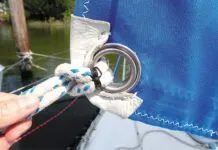Boat restorer and broker Glen Simmons took time out from painting a 2004 Catalina 36 to share some tips with PS. Simmons has perfected a roll-and-tip technique with Awlgrip that will also work with more DIY-friendly products. For more detailed guidance and results of our own paint tests, follow the links in the Inside PS blog post “Painting Your Boat Like a Pro”).
PREP, PREP, PREP
Eighty percent of the work is filling, fairing and sanding.
Repairing: Avoid over-building repairs; this just means more sanding. If possible, use same resins for repairs that the builder did for laminating.
Fairing: Use only premium grade fairing compounds. Feather any damaged areas to at least a 15:1 ratio.
Sanding: Use a dye like 3M Dry Guide to highlight high spots.
Grit: Use 180 grit before the first primer coat to promote adhesion. Simmons uses Diablo Sandnet with his DA sander. Before and between (if needed) coats, he uses 320 grit.
Priming: Strictly follow the paintmakers instructions on surface cleaners, solvents, and primers.
PAINTING TOOLS, CONDITIONS
One person rolling and one tipping with a brush is the norm, but Simmons likes to work alone.
Roller: Must be high-grade foam, solvent resistent. Brush: Use 2.5- to 3-inch badger hair brush. Cut half of the brush hairs off and taper toward the tip. This aids the soft touch needed for a glass-like finish.
Weather: Temperatures of 70-75F (21-23C) are ideal, no wind, and at least 70 percent humidity.
Primer: If the boat is a light color, use a light base primer that is as close in color to the final color. No dark primers for light-colored boats.
PAINTING TECHNIQUE
For his last project, Simmons primed with Awlgrip 545 (D8001) two-part epoxy base primer, the top coat was Awlgrip (G8089), a linear polyurethane paint (LPU).
Primer: Apply two or three (preferred) coats for base. Alternate with very thin vertical and horizontal coats.
Between coats: Sanding between primer coats is not required. If you do, wait at least 16 hours before sanding. Use tack cloth to get rid of dust. Sand (320-grit) and wipe with tack cloth to prep for topcoat.
Mixing: Mix a small batch of Awlgrip paint and Awlcat #3 Topcoat Converter at 2:1 ratio. Let the mixed paint sit 15 minutes. Add about 15 percent of brushing (T0031) Reducer (this will be increased up to 25 percent a little at a time as needed for flow). Pot life is only 45 minutes, so don’t mix too much paint at once.
Flow: To test flow, put a little reducer in the tray, add a little paint, roll and apply. It should flow easily, not cling to the roller at all. If it’s sticky, add reducer.
Working time: Once you pour the paint into the tray, it dries more quickly. You have about 10-15 minutes of painting time, so work in small sections of 2-3 square feet.
Rolling: Roll vertically, bottom to top. Thin coats! Don’t sweat the bubbles, the brush will get rid of them.
Tipping: Brush horizontally, and lightly. The brush is for knocking down bubbles, not painting.
Coats: You can skip sanding between coats if the paint is still tacky. The Catalina took four coats; Simmons sanded between the second and third coat.
Bugs: Wait till the paint dries to buff them out.
For a detailed guide to restoring an old boat back to better than new finish, our new four-volume ebook series “Painting your Boat: The Complete Series,” covers the topic from keel to masthead.




































Repair of Rotten Core and Delaminations:
I was very excited to see this article. I’ve been planning doing this work for summer—one week it’s too hot, the next it’s too wet.
Easy to put off, a daunting process. This article has vaulted me into action.
I’ve got the ultimate “project boat” (it came for free, the “most expensive boat I’ll ever own”). It’s an Albin 27FC Trawler, with the cockpit window frames leaking into the balsa sandwich core a couple of inches. The boat is tarped, has been for several years, so I’m sure of dryness. I’m digging out the old rotted balsa. Then the slots can be filled with strips of stiff foam 1/2” sheets, slathered with Gorilla Glue, thus providing watertight integrity.
I have two horizontal decks that are soft and will address that work next.
This is a 1983 boat, and has been on the hard for over 10 years. Today is cool and dry: Gorilla Glue time!!